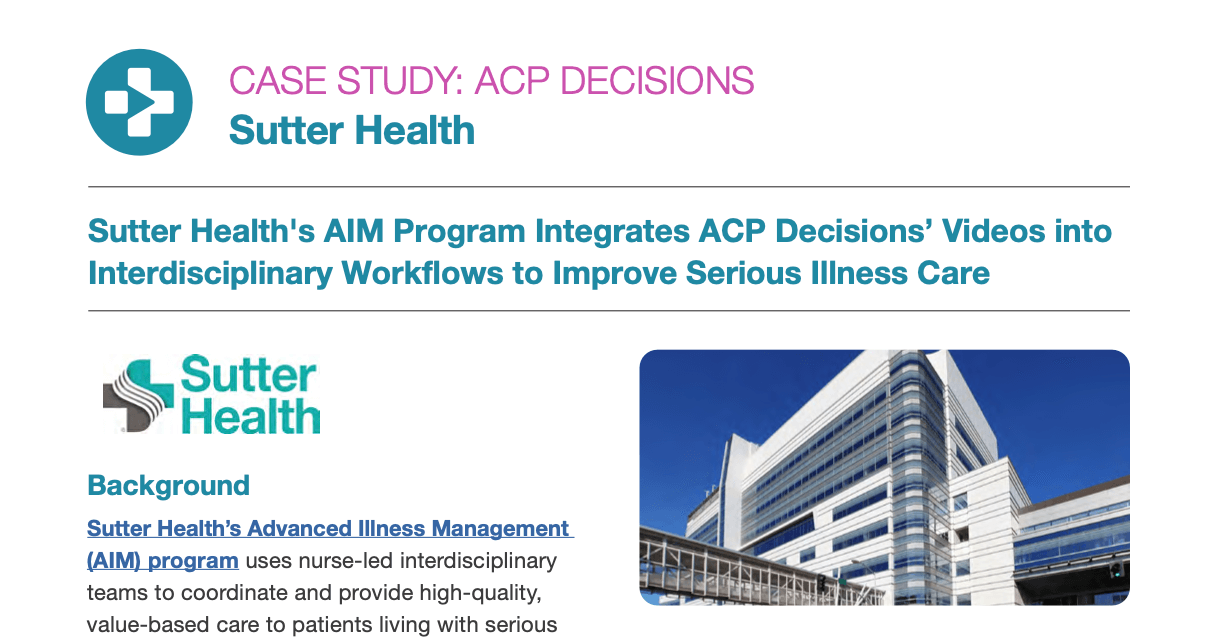IMPLEMENTATION | December 4, 2019
Implementation Series: Identifying Opportunities for Better Clinical Workflows
Reading Time: 4 minutes

This four-part implementation series explores expected challenges healthcare organizations may encounter when adopting an improvement initiative. Each article provides tips for effective implementation based on our experience working with organizations to successfully execute an advance care planning initiative.
The first installment took a closer look at the challenge of training clinicians to develop the skills necessary to effectively carry out a new initiative. In this installment, we offer tips on how to accurately identify areas to improve clinical workflow both during and after implementation. Future installments will explore challenges related to inpatient settings and outpatient settings.
The introduction of an improvement initiative invariably alters clinical and administrative processes. It is not uncommon for a clinic, unit, or entire healthcare system to discover unanticipated disruptions to existing workflows after an implementation. These disruptions can adversely impact patient care, communication, billing, and even the morale of the staff and providers.
Workflow is defined by AHRQ as “the sequence of physical and mental tasks performed by various people within and between work environments.” Understanding workflow and preparing for changes throughout the planning and implementation phases are critical to the success of any initiative.
Even when an implementation seems like a simple change, it can be much more complex and challenging than expected. That’s why it is necessary to conduct a thorough workflow analysis. Process mapping and flowcharting are the recommended methods for capturing every step of an existing workflow and assessing inefficiencies and bottleneck within the process.
Organizations that are thoughtful about workflow design and able to identify how workflows will change are more likely to be successful in adapting to and adopting an improvement initiative. While there is no one-size-fits-all approach to workflow analysis, there are several guiding principles that every implementation team should consider for identifying opportunities to improve the post-implementation clinical workflow.
Use an Interdisciplinary Approach
Evidence shows the interdisciplinary involvement is vital in all aspects of workflow analysis and implementation. Individuals in various roles from different disciplines and departments bring different perspectives and experiences. Considering ideas from multiple sources of data will help your team develop a more complete understanding of workflow. Ultimately, an interdisciplinary approach will improve communication, promote compromise, and help everyone have an accurate picture of what will be involved in the change.
Embrace the Opportunity of Frontline Resistance
Don’t underestimate the value of resistance from your frontline staff. Pushback from these subject matter experts should be viewed as an opportunity to properly design and tweak workflows. When analyzing and redesigning workflow, it is essential to involve all key personnel. By interviewing frontline staff and getting their perspective, they will be engaged in the process and bring insights and experiences based on direct clinical observation. Additionally, since they may be involved in the workflow process, they can provide a more accurate picture of the workflow process.
Focus on Efficiency

Making workflow processes more efficient before an implementation can save a great deal of time, frustration, and difficulty later. During workflow analysis, identify where it is possible to simplify a process, eliminate steps that are redundant or unnecessary, and combine or automate tasks. Prioritize your analysis on those tasks that consume a lot of time or resources.
Interview the individuals who are involved in carrying out each process in the workflow to help identify areas to simplify and improve efficiency. Questions that can guide these discussions include:
- What are the tasks or steps involved in this process?
- Are there any variations to these steps?
- Are there acceptable reasons to vary from the process?
- Who initiates and completes the process?
- Do several types of staff perform the same tasks?
- Would you consider this an example of cross-training or a duplication of effort?
- How long does it take?
- What are the bottlenecks where the process gets interrupted or slowed?
- Do some tasks need to be done more than once during the process?
Break Down Improvement into Stages

After identifying opportunities to improve workflow processes, prioritize each one based on its importance. Then consider making incremental changes by testing out just one or a few of the new processes at a time. Using a quality improvement method such as PDSA, will help you audit and tweak workflows in a continuous improvement cycle. Evaluating the effectiveness of each process in your workflow and adjusting in stages will ensure small wins along the way while helping you achieve the best outcome at the end of each process.
For more information about assessing workflow, check out AHRQ’s Workflow Assessment for Health IT Toolkit. Implementing a new advance care planning initiative or interested in improving the advance care planning process at your organization? ACP Decisions can help. Contact us today to learn more!
You might also like...

Sutter Health’s AIM Program Integrates ACP...
CASE STUDIES, IMPLEMENTATION | < 1 MIN READ



